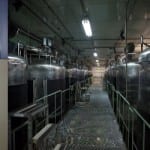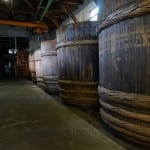 At a recent event celebrating the 100th anniversary of a particular brewer, I found myself sitting across from another brewer. As we chatted, it became clear to me that he was a particularly clever marketing person. His sake has an aura of exclusivity to it, no doubt fueled by the owner’s crafty ideas – one of which he shared with me.
At a recent event celebrating the 100th anniversary of a particular brewer, I found myself sitting across from another brewer. As we chatted, it became clear to me that he was a particularly clever marketing person. His sake has an aura of exclusivity to it, no doubt fueled by the owner’s crafty ideas – one of which he shared with me.
“Lemme show you something; didja ever try this?” he began. He pointed one of the several bottles sitting on the table that awaited consumption. The official “kanpai” had not yet been offered, so we had to resign ourselves to just looking for the time being.I was at first just a bit patronizing. But he soon had my attention.
“What do you see here, just above the sake, in the very top of this bottle?”
“Uh, air?,” I replied, genuinely confused at where he was heading.
“That’s right,” he shot back, putting my mind at ease. “That little bit of air is from the inside of the kura in which this sake was brewed. So, just upon opening a bottle  of sake, before pouring it out, if you smell that and breathe it in, you are literally breathing and tasting the air of the kura itself. Trust me: doing that will really enhance the experience with that sake.”
of sake, before pouring it out, if you smell that and breathe it in, you are literally breathing and tasting the air of the kura itself. Trust me: doing that will really enhance the experience with that sake.”
This seemed genuinely interesting to me, its lack of scientific grounding notwithstanding. And so I tried it, a bit selfishly, on all the bottles on our table within my reach. No one noticed what I was doing but him, so no harm done.
Not surprisingly, it smelled like air. It smelled too like sake, especially the daiginjo bottles I opened. But I do admit there was something else, some vibe or feeling that consciously breathing in the air of kura evoked. And I also admit that the sake seemed to resonate with me more from the bottles on which I tried this. Imagination? Certainly, to some degree. But that’s cool.
 There are of course downsides to this practice. Only one person gets to breathe in that kura-air. How does a group of drinkers decide this? Also, a couple of breweries put in nitrogen at the top to stave off any vestiges of oxidation. So that would mean we are breathing in the nitrogen from a gas factory in Saitama, then, right? But I digress.
There are of course downsides to this practice. Only one person gets to breathe in that kura-air. How does a group of drinkers decide this? Also, a couple of breweries put in nitrogen at the top to stave off any vestiges of oxidation. So that would mean we are breathing in the nitrogen from a gas factory in Saitama, then, right? But I digress.
Give it a try. Next time you open a bottle of sake, surreptitiously breathe in the air from a kura that has been making that sake for a long, long time. Odds are the sake will actually taste better
~~~~~~~~~~~~~~~~~~~~~~~~~~~~~~~~~~~~~~~~~~~~~~~~~~
The next Sake Professional Course will be held in Las Vegas on December 4 – 6. Click here for more information.




